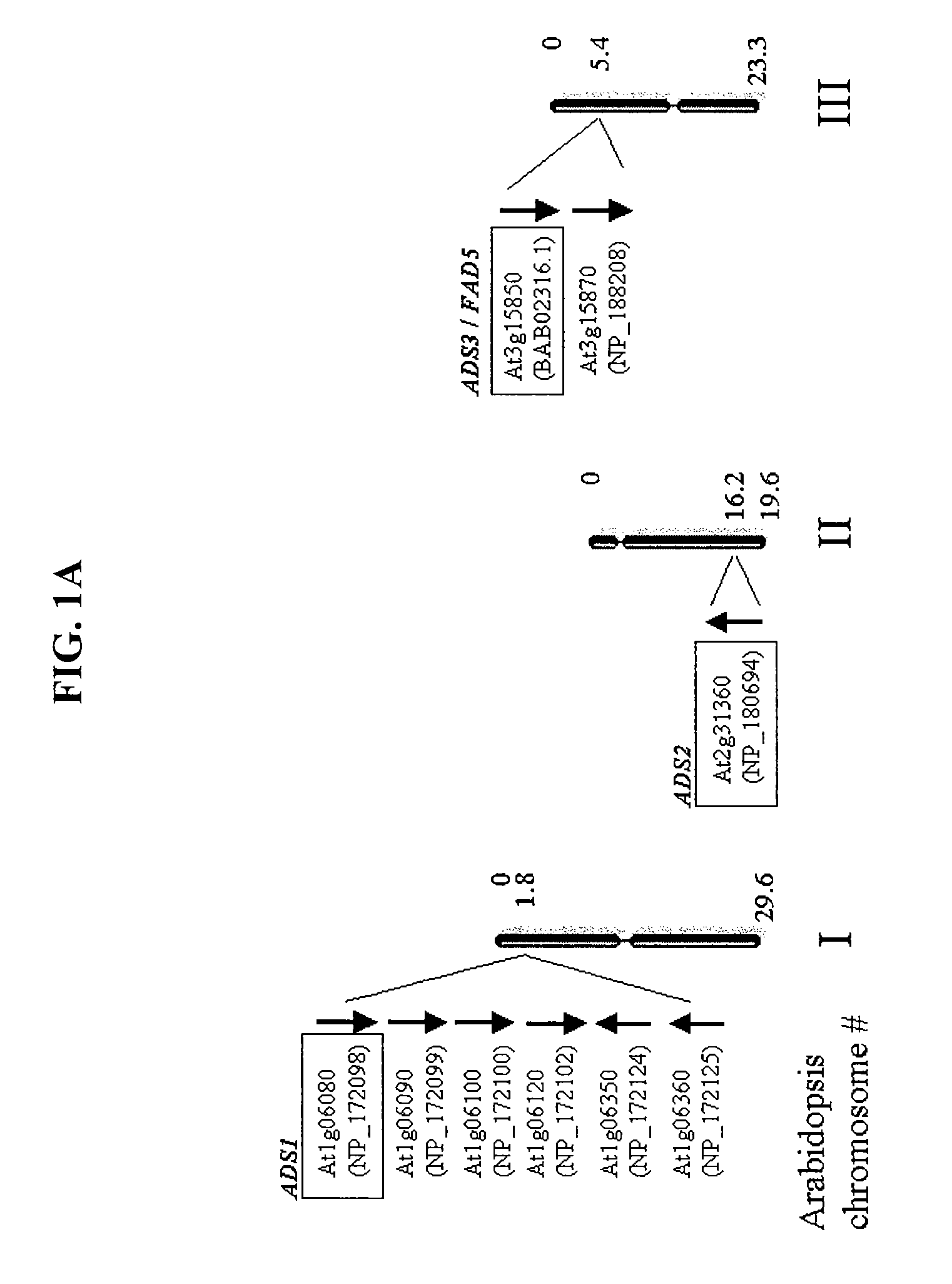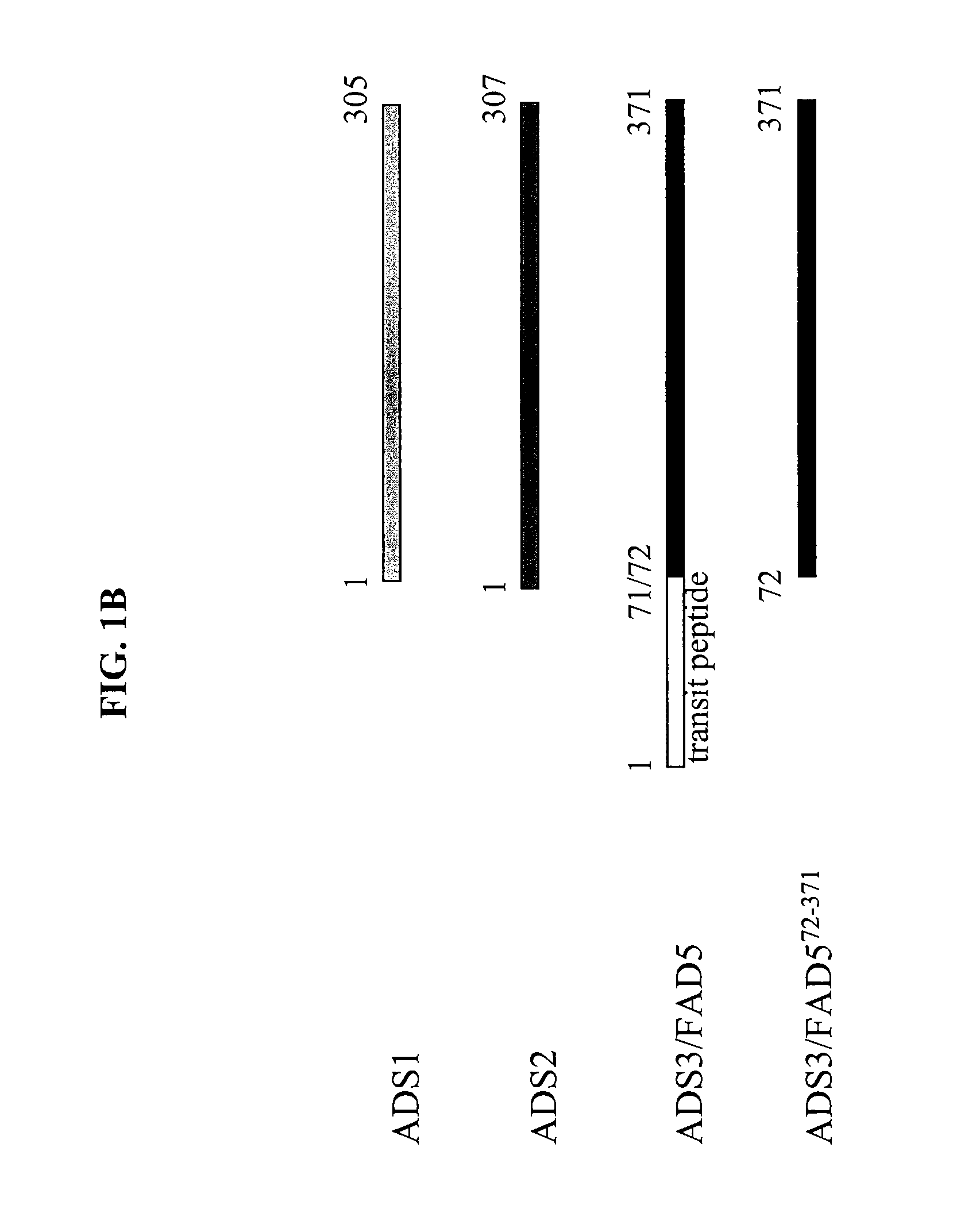ADS Genes For Reducing Saturated Fatty Acid Levels In Seed Oils
a technology of saturated fatty acid and seed oil, which is applied in the field of lipid metabolism-related enzymes, can solve the problems that the fatty acid content alterations are not substantial enough to create truly meaningful new oilseeds, and achieve the effect of increasing saturated fatty acid
- Summary
- Abstract
- Description
- Claims
- Application Information
AI Technical Summary
Benefits of technology
Problems solved by technology
Method used
Image
Examples
example 1
Materials and Methods
[0300]This example describes the materials and methods used in the characterization of ADS genes.
Yeast Growth and Transformation
[0301]The DTY10A-derived yeast strain DTY11A disrupted in the OLE1 gene and exhibiting no endogenous fatty acid desaturation was used as a host for complementation experiments. Cultures were initiated from single colonies and grown at 30° C. in synthetic complete medium without uracil, pH 6, containing 4% (w / w) glycerol and 0.8% (w / w) glucose (SC-ura). For growth of DTY11A, SC-ura was supplemented with 5 mM each of palmitoleic and oleic acid in final 0.1% (w / w) tergitol (SC-ura+FA). Solid media contained 1.2% (w / w) agar, 18% (w / w) sorbitol, and 1% (w / w) tergitol.
[0302]For growth experiments, 5-ml DTY11A cultures were grown in SC-ura+FA over night at 30° C. shaking at 150 rpm up to an optical density (OD) of approximately 2. Cells were pelleted by centrifugation, washed once in SC-ura and carefully resuspended. With the obtained cell mat...
example 2
Characterization of ADS Genes
[0313]This example describes the results of experiments characterizing ADS genes.
Expression of ADS1, ADS2 and ADS372-371 in the Yeast Unsaturated Fatty Acid Auxotroph DTY11A Overcomes the Requirement for Unsaturated Fatty Acid Supplementation.
[0314]In order to functionally test the ADS desaturases, whether they would complement an unsaturated fatty acid auxotroph DTY11A, a yeast strain in which the Δ9-stearoyl-CoA desaturase had been deleted, was examined. ADS1, ADS2 and ADS3 minus its transit peptide (ADS372-371) were expressed under the GAL1 promoter. Functional complementation was observed with all three constructs, because significant growth was observed in the absence of desaturated fatty acid supplementation (FIG. 2). The growth rates observed were slower that those for parental lines containing the endogenous yeast desaturase. Rates were somewhat variable between experiments, and complementation was not observed on solid media. Expression of Yep35...
example 3
Switching of Desaturase Specificity
A. Materials and Methods
[0319]cDNA Constructs
[0320]For yeast expression, cDNAs for ADS1, ADS2 and ADS3 lacking a transit peptide coding sequence (i.e. ADS372-371) were generated by polymerase chain reaction (PCR) from Arabidopsis flower cDNA using the primer combinations 5′-GCCTGGATCCATGTCATTGTCAGCCTCGGAGAAGG-3′ (SEQ ID NO:30) / 5′-CAGTGAGCTCCGAGACGTCGTTCCATATCTTCAACG-3′ (SEQ ID NO:31), 5′-GCCTGGATCCATGTCGGTGACATCAACGGTGG-3′ (SEQ ID NO:32) / 5′-CAGTGAGCTCTCAACGAACTATAGCCATACGACG-3′ (SEQ ID NO:33), and 5′-GCATGGATCCATGGGAGATTACAGAAGGATA-3′ (SEQ ID NO:34) / 5′-CAGTGAATTCATACCTTTAAGTAAACACAAAAAAGC-3′ (Primer A; SEQ ID NO:35), respectively. The complete ADS3 coding region was amplified using the primer combination 5′-CAGTGGATCCTAAGTTAAGGGTTTAAGCCTCTTCTC-3′ (SEQ ID NO:36) / Primer A. ADS1, ADS2, and ADS372-371 were inserted as BamHI / SacI fragments into Yep352YOPR (Shanklin et al., (1994) Biochemistry 33, 12787-12794) and as BamHI / EcoRI fragments into the yeast ...
PUM
| Property | Measurement | Unit |
|---|---|---|
| nucleic acid sequence | aaaaa | aaaaa |
| concentration | aaaaa | aaaaa |
| structures | aaaaa | aaaaa |
Abstract
Description
Claims
Application Information
 Login to View More
Login to View More - R&D
- Intellectual Property
- Life Sciences
- Materials
- Tech Scout
- Unparalleled Data Quality
- Higher Quality Content
- 60% Fewer Hallucinations
Browse by: Latest US Patents, China's latest patents, Technical Efficacy Thesaurus, Application Domain, Technology Topic, Popular Technical Reports.
© 2025 PatSnap. All rights reserved.Legal|Privacy policy|Modern Slavery Act Transparency Statement|Sitemap|About US| Contact US: help@patsnap.com



